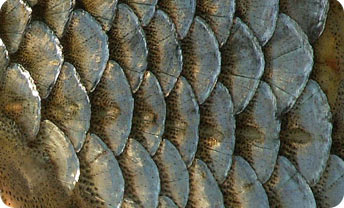A school of fish often looks like a marching band following a drum major. The entire school maneuvers as a single unit, with everyone turning at almost the same instant.
 Scales of the lateral line. Credit: Wikipedia/Piet Spaans
Scales of the lateral line. Credit: Wikipedia/Piet SpaansThe fish aren’t following instructions, although they are following a leader. They respond so quickly because of a system that’s a lot like the workings of our inner ears.
The system is known as a lateral line -- small sensory organs arrayed around the fish’s head and in lines across both sides of its body.
The organs themselves are called neuromasts. They consist of tiny hairs that are topped by a layer of jelly. The structures are similar to the hairs in our own ears, and perform a similar function -- responding to small motions in the environment.
As a fish swims, it pushes the water aside, creating small waves in the water. When a wave hits other surfaces -- like the ocean floor or another fish -- it reflects back to the fish. Other fish generate waves, too. These motions jiggle the neuromasts, triggering electrical impulses that travel to the brain. The impulses help the fish build a picture of its surroundings.
A fish uses its lateral line to detect prey, avoid predators, sense currents, and even find mates. The system also helps fish swim in schools by “feeling” changes in the motion of the fish around them -- allowing the whole school to march to the same beat.
A more highly evolved system in sharks and rays allows them to follow the beat, too -- the beat of a passing fish’s heart. More about that on our next program.

